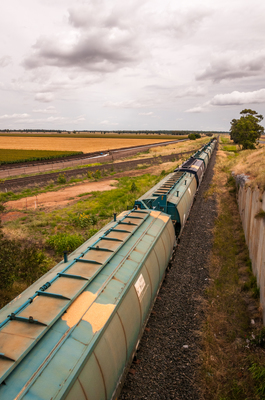By Jeremy Sollars
Warwick is still no closer to knowing how – or indeed if – we will be linked to the planned Melbourne to Brisbane inland railway.
The Federal Budget handed down last week contains $8.4 billion for the project but – despite the Southern Downs Regional Council lobbying for months for Warwick to be included – the final route remains officially up in the air.
Federal Maranoa MP David Littleproud said the route-planning process was “ongoing”, accusing project driver the Australian Rail Track Corporation (ARTC) of a “lack of engagement with potentially-affected landholders” in his electorate.
In reality however the ARTC has a clearly-preferred route it has pushed all along which excludes Warwick – and comments last week by Federal Transport and Infrastructure Minister Darren Chester suggest the Turnbull Government is backing it too.
The ARTC’s preferred route from the Queensland-New South Wales border would see the line run from Boggabilla to Yelarbon, Whetstone and Inglewood and then north to Millmerran, Pampas and Brookstead and Oakey, before heading north-east to Gowrie just outside Toowoomba.
From there it would head down the range to Helidon, through Gatton and the Laidley and Grandchester areas and southwest to Kagaru near Jimboomba, south of Brisbane.
The final leg would continue east to Bromelton near Beaudesert and then north on existing lines to Acacia Ridge in Brisbane’s south and then on to the Port of Brisbane.
The inland rail route – and others previously put up – includes sections of existing rail but many new links, including tunnels and other heavy engineering, would be required to link everything together.
The preferred ARTC route does not take in Toowoomba’s Wellcamp Airport, seen by many as a glaring omission.
Warwick’s inland rail proponents favour a loop on existing lines from Inglewood to the east through Karara to just north of Warwick – in the Toolburra Plains area between Warwick and Allora – rather than the Millmerran option.
They also say taking the route this way would enable the existing line north of Warwick and through Clifton, Greenmount, Cambooya and Wyreema to be extended to take in Wellcamp Airport and then on to Gowrie.
Similar wrangling is going on in New South Wales and Victoria with communities likewise squabbling over the route, with each town and their respective councils and State and Federal MPs pushing options each says would be cheaper to build and would result in quicker travel times.
One prime example is a push from a group of southern councils calling itself the ‘Food Bowl Inland Rail Alliance, which is lobbying for the route to be brought through the fruit-growing regions of Shepparton in Victoria and Jerilderie and Narrandera in NSW.
Last week Minister Chester told southern media there was no plan by the Turnbull government to change the ARTC’s preferred route through Victoria and New South Wales – through Albury and Wagga Wagga and north to Parkes, Narromine, Narrabri, Moree and North Star.
It’s unclear if the minister’s comments also apply to the ARTC’s preferred route through Queensland, but what is not in doubt is that a Melbourne to Brisbane inland railway has been a long-held passion of the Nationals.
This is despite a 2015 report by former Nationals leader John Anderson suggesting an inland railway would be a marginal public investment.
Mr Anderson – who chaired a Federal Government inland rail implementation group which produced the report – found the project would deliver a net economic benefit for Australia but predicted the operating revenue over the next 50 years was unlikely to cover the initial capital investment and so the project would not attract sufficient private-sector investment.
Mr Littleproud acknowledged that inland rail has been “a century-old dream” but said the Turnbull government was “committed to getting this economy-building infrastructure completed”.
“Economic analysis found this project would create 16,000 jobs during construction and, once completed, it’s projected this infrastructure would allow freight companies and producers to transport goods from Brisbane to Melbourne in less than 24 hours,” Mr Littleproud told the Free Times.
“Inland Rail has the capacity to take thousands of trucks off our highways daily and will offer primary producers massive cuts in transport costs.”
Mr Littleproud said he had been “instrumental” in the establishment of a terms of reference for a review into the proposed Queensland Inland Rail route from Yelarbon to Gowrie.
“I want to make sure this nation-building infrastructure investment offers the route of best return for my electorate,” he said.
“Just three days after being elected as the Maranoa MP – I attended the impacted landholders’ meeting in Millwood on the proposed Millmerran/Cecil Plains alignment – and the lack of engagement with landholders was both obvious and concerning to me.
“I also couldn’t believe a Warwick route hadn’t properly been considered and I made sure my colleague and the Infrastructure Minister Darren Chester certainly knew about my bewilderment regarding this omission.
“It also makes sense Toowoomba’s new Brisbane West Wellcamp Airport also be included in the route planning as the airport enables Maranoa producers to easily access overseas markets.
“As a result of the track alignment’s concern, the Australian Rail Track Corporation and State and Federal parliamentarians – including the Federal Infrastructure Minister – all met in Warwick to discuss route options through my electorate.
“This process is still ongoing – and the minister’s carefully considering the PRG report and other expert advice and has not reached any decision.
“But I’ve always said, you shouldn’t spend taxpayers’ dollars on a whim because we’ll only get one shot at this massive project and I’m going to make sure we get it right.”
Critics of the Yelarbon to Gowrie route via Millmerran claim major engineering works would need to be undertaken on floodplains in that area to make any new sections of line capable of withstanding flooding.







